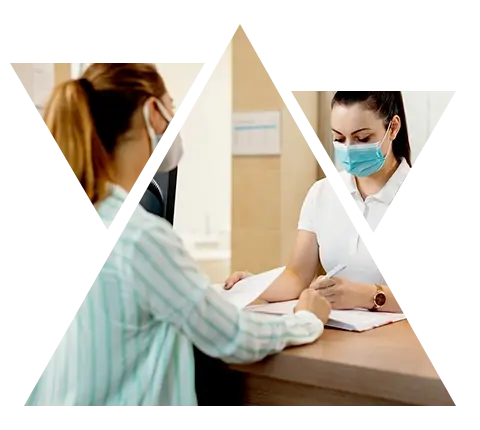Trusted Partner
Best Medical Billing Services in USA
Are you a physical or solo practitioner, unable to handle billing for claim processing while focusing on patients? Outsourced medical billing services to eClaim Solution, as our experts always ensure that claims are processed on time, resulting in fast and accurate reimbursements. Whether you face continuous claim rejections or denials, our medical billing services are the best solution for all your billing issues. Recover your payments with our professional billing solutions in the USA. Our RCM experts are always here to support, whether you need 24/7 billing support or a consultation.
Book A Free Consultation

At Your Service
How Our Experts Handle Your Medical Coding & Billing in USA
Coding for claim submission is a crucial and complex part of the medical billing process; if not done correctly, denials can occur. We provide accurate medical coding and billing services to ensure our clients receive payment faster.
Precision-Driven Approach
Our skilled and experienced coding department uses a precision-driven, quality-assured approach to ensure every claim is accurate and gets paid the first time without delays.
Regulatory Compliance
To meet the standards of HIPAA policies, our medical billing team stays up to date, ensuring each step of the process runs smoothly and accurately, and preventing payment delays.
Precision-Driven Approach
Our coding department always uses a precision-driven approach to ensure every claim is accurate before submission, so the claim gets paid the first time.
Regulatory Compliance
To meet the standards of HIPAA policies, our medical billing team stays up to date, ensuring each step of the process runs smoothly and accurately, and preventing payment delays.
Significant Results for Small Practices - That's Our Billing Promise
Our best medical billing and management services drive significant results for healthcare providers across the USA, especially for the small practices that face challenges in the billing process.
Accurate Coding
Collection Ratio
Fast Reimbursements
Financial Cost Reduction
Billing Compliance
We Serve Our Medical Billing Services to More Than 50+ Specialties Across the USA.

Cardiology Billing Services
We understand the complex billing process for cardiologists, so we handle it with precision. From EKGs, stress tests, and echocardiograms, our medical billing professionals track all records and data before claim submission to ensure first-time acceptance from payers.

Urgent Care Billing Services
We understand the complexity of urgent care billing, so we offer 24/7 billing support to ensure providers get paid on time. Our team of experts efficiently and accurately handles high patient volume billings, ensuring you never need to wait long for your payments.

Physician Billing Services
To help physicians get paid on time, we provide accurate coding, manage denials frequently, and pass the first-time claim ratio. From the family doctors to a podiatrist, we provide expert healthcare billing solutions to help them receive payments faster than ever.

We have your back if you’re a therapist or psychologist facing unique billing challenges every day. Our automated patient billing services fix coding errors, submit claims on time, which reduces denials, and recover lost revenue.
Our Medical Billing Process That Maximizes Revenue
To stand out in the USA’s competitive market of medical billing services, our experts ensure every step of the process generates revenue. Look at how we work;
01
Detailed Analysis
Our team of experts starts by conducting a detailed analysis based on your practice’s needs and unique goals to identify the challenges you face.
02
Patient Verification
Following detailed analysis, our experts verify whether the patient’s insurance coverage verification is valid or expires before claim submission to ensure a smooth billing process.
03
Coding & Billing
Next, our billing experts carefully assign the right CPT, ICD, and HCPCS codes for every procedure to make sure each claim is accurate and ready for payment approval.
04
Claim Submission
Now, we submit medical claims to the insurance company while ensuring they align with payer-specific rules and regulations for faster claim approvals.
05
Payment Posting
Once payments are received, our team reviews and posts them accurately in your billing system. We reconcile payments with claims and identify any partial payments or adjustments to maintain transparent records.
06
Follow up
Our follow-up team investigates immediately if a claim is delayed, denied, or underpaid. We correct errors, appeal denials, and resubmit claims to ensure every dollar owed to your practice is recovered efficiently.
Why Providers Trust Us for their Medical Billing in the USA
Every provider wants to be paid on time without any stress or delays, and that’s our promise! With us, you always receive payment on time, the denial ratio becomes 5%, and revenue increases by 25% to 30%.
- HIPAA-compliant services
- EHR software integration
- Lowers Financial Cost
- Specialty-Focused Expertise
- Proactive Approach
- Certified Billing Experts
With our best medical billing services in the USA, more than 500 clients experience 99% billing accuracy, as our expert double-checks every claim before submission.
Over 500 healthcare providers trust us to maintain a claim denial rate below 2% through accurate coding and clean submissions every time.
Seamless EHR Integration
We integrate with any EHR system to ensure all data is synced correctly.
Monitor each claim instantly with automated alerts and instant time updates.
Ensures error-free claim processing, maximizing revenue.
Beyond Medical Billing — Discover More Ways We Support You
Revenue Cycle Management
We also support providers by offering the best revenue cycle management services. Our experts ensure accuracy to achieve higher revenue results and boost cash flow.
Denial Management
We provide denial management services to support healthcare providers in recovering lost revenue and steady cash flow.
Our experts verify patients’ insurance coverage before submitting claims to reduce denials and improve cash flow.
Credentialing Services
We handle provider enrollments, payer contracting, and renewals, so you can stay focused on your patients while we handle the paperwork.
Key Benefits of Our Medical Billing Services in USA
Long-Term Financial Growth
Our healthcare billing solutions offer long-term financial growth to every practitioner and doctor across the USA by automated claim submission and tracking, consistent checks of insurance payer policies, and a proactive denials approach.
Cost Reductions Up to 40%
With our expert billing services, you’ll save up to 40%, reduce administrative workload, and focus more on patient care.
Revenue Generated by 25-30%
With us, you’ll experience a 25-30% increase in revenue and recover lost payments, as we process claims timely and follow up till approved by payers.
Instant Billing Support
Our experts provide instant billing support for your every query, anytime, anywhere across the USA, to ensure you get answers for every billing issue.
100% HIPAA-Compliance
Our medical billing services are 100% HIPAA-compliant, and we follow insurance-specific policies at every step of the process, preventing denials.
Lower Denial Rates
Our proactive approach and accurate coding ensure denial rates lower than 5% and maximize revenue for every practice.
Outsource Your Billing & Receive 99% Accurate Results With Us.
Quick Analysis
Backed by over a decade of expertise, we deliver quick, specialty-focused analysis that identifies billing gaps and accelerates reimbursements.
24/7 Support
Our dedicated team of billing and coding experts provides 24/7 support to help the facility providers receive timely payments.
Automated Solutions
We use automated billing tools and advanced solutions to streamline the RCM process, reduce repetitive tasks, and minimize claim submission errors.
Fast Reimbursements
Outsourcing medical billing services to us helps you increase 3x faster reimbursements and boost cash flow.

Simplified Billing & Better Patient Experience With Us
Do you face challenges in handling both billing and patients? At eClaim Solution, we are dedicated to providing the best medical billing services in USA, which streamlines the billing process and accelerates your revenue growth. We maintain 98% compliance with safety standards, 92% clean claim submission rates, and a 30% payment increase. Connect with us to experience better billing and patient care without any stress!
Frequently Asked Questions
Yes ofcourse! We provide medical billing services for small practices, ensuring they receive timely payments while focusing on patient care.
Yes, we provide medical coding services to all specialties across the USA. Our dedicated team ensures that medical codes are accurate, preventing denials or rejections.
For accurate billing in medical services, we use Therapynotes, eClinicalWorks, OfficeAlly, and more, which reduce denials and maximize revenue.
If denials occur, our denial management team identifies the root cause, creates a strong appeal letter, and resubmits the claim to the payer for fast reimbursement.
Our experts have vast knowledge and years of expertise in providing medical billing services across the USA, based on state policies. Our professionals cover various states of the USA, including Pennsylvania, California, New York, New Jersey, Michigan, Indiana, Illinois, and Texas.